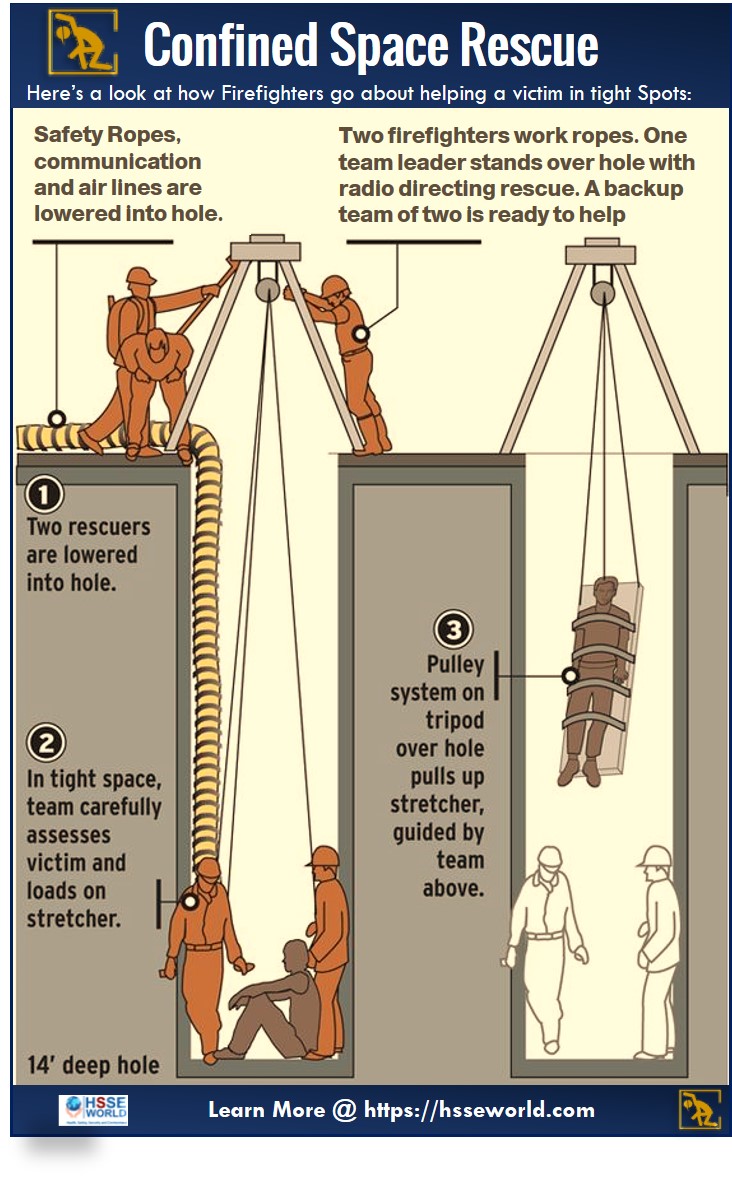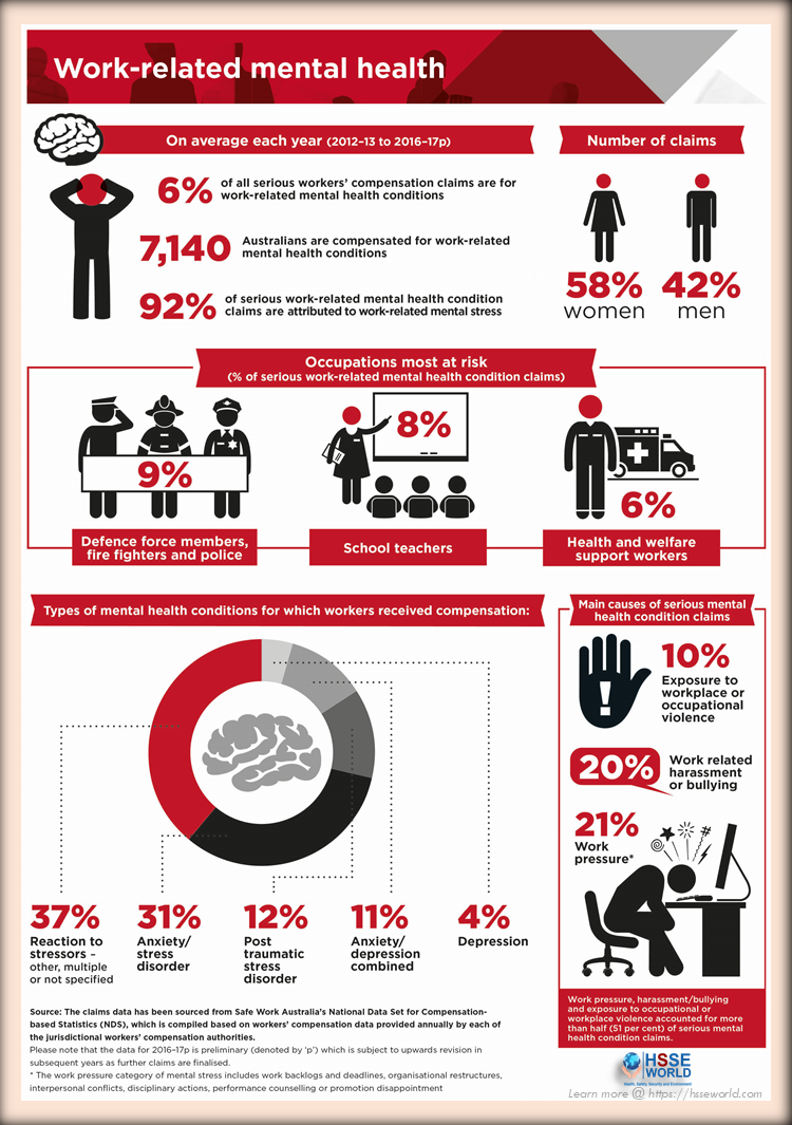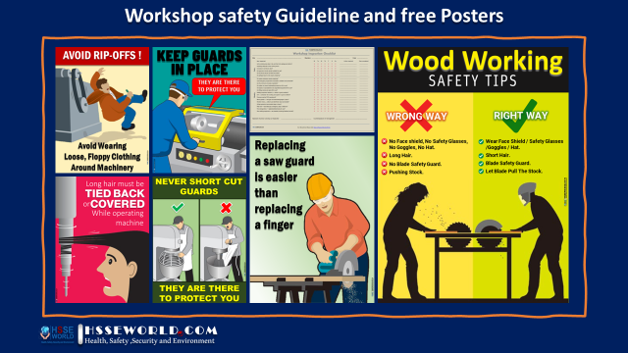The photo of today will discuss procedures for confined space rescue operations and emphasizes the need for safe operating procedures. Practice and proficiency using mechanical- will advantage systems, anchors, and rescue equipment are critical to the safety of all response personnel involved.
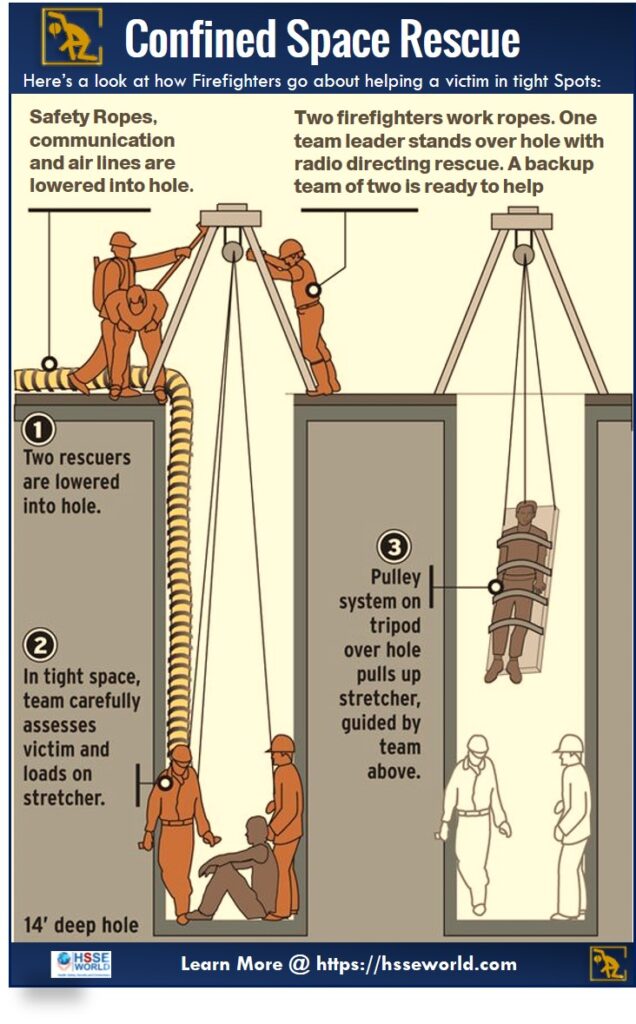
Emergency Rescue – The Change in Perspective
Emergency rescue from a confined space is a matter of life and/or death. To this point, we have concentrated upon routine entry and exit procedures. It may have appeared that we have not been making life and death decisions in these routine processes, but in fact, we have. When we routinely evaluate the space and perform the entry in accordance with the permit, we are making decisions that may mean the difference between a problem-free entry and a body recovery. Many of these same thought processes that are required in emergency rescue are also used in the routine entry. If that is the case, why is it so much more difficult to perform in an emergency setting? Lack of time is the critical factor. A sense of urgency is sometimes used as an excuse for making decisions or performing actions that place others at undue risk. Following are a few emergency rescue operation priorities.
The first priority is to keep all rescuers alive. It may seem callous, but you did not create this situation. It is your job to do everything that you and your fellow rescuers can SAFELY do to help the victim. However, there will be situations that you will not be able to help. It is critical that the person in charge of the rescue effort recognize when the risk to the rescuers surpasses the gain to the victim. When the risk is evaluated to be too great, it is imperative that the person in charge has sufficient character to delay or suspend the rescue effort even when that decision is unpopular.
Do not substitute emotion for intellect. In many cases, the people involved in the emergency will be under a great deal of emotional distress. This is especially true if the victim is a co-worker. Heightened emotion and a sense of urgency can also be a problem for the person in charge of the rescue. Bystanders and co-workers of the victim may exert great pressure to act on the person in charge. If the person in charge is not prepared for this, he/she may well get caught up in a flood of well-meaning but tactically incorrect thinking
Don’t take shortcuts. As stated before, time is the enemy in rescue operations. Don’t allow rescuers to take shortcuts in appropriate procedures for the sake of saving time. This is especially true in space evaluation. If an emergency occurs in a space, a permit-like evaluation procedure needs to be performed unless the cause for the emergency can be unequivocally identified. Most of the time, short- cuts don’t save all that much time anyway. (Ever get lost taking a “shortcut”?) Rather than relying on shortcuts to shave time off of the response, practice, training, and preparation can maximize efficiency and enhance safety.
The person in charge may choose to isolate themselves. By being in a remote location, the person in charge can insulate himself/herself from the emotion of the rescue. Furthermore, this individual can choose with whom they will interact. There are no screaming bystanders or irate supervisors to deal with. Isolation may also improve access to communication facilities, technical information, or other resources that may prove helpful in the effort. Isolation is a matter of personal choice. If the person in charge chooses to be at the site of the rescue, however, they should already have the mental mechanisms in place to deal with the distractions.
Preplanning and training. The more your rescue team knows before the emergency, the safer and more efficient the rescue will be. Especially if you are an on-site rescue team, you should know the hazards that you will be faced with ahead of time. Equipment and personnel requirements should also have been determined in advance. Preplanning will help to identify the needed equipment and personnel. Training will turn equipment and personnel into a functional unit. While it is impossible to anticipate every situation, trained personnel with a well-rounded background in rescue principles will be able to address the emergency in as efficient a manner as possible.
Every person who is involved in a confined space rescue must not only have a mental image of the technical aspects of the rescue but should also anticipate the entire range of emotional reactions that one would expect to encounter. Most people who deal in the emergency arena daily indicate that the keys to being a successful emergency worker are the ability to concentrate under pressure and the control of personal emotion. Once these hurdles are crossed, one can think clearly and allow their training and experience to dictate their tactical objectives.
Confined Space Rescue
Confined space emergencies are one of the leading causes of multiple deaths in the workplace. In most cases, the emergency began with very few people in the space. Then untrained and/or unprotected “rescuers” added to the problem by entering the space and becoming victims themselves. As stated before, about 60 percent of victims are would-be rescuers. Additionally, a majority of these individuals are supervisors and/or senior personnel who should know better. Oddly enough, there are many cases where the initial entrants survive and the would-be rescuers die.
The regulation mandates that an employer ensures the availability of rescue services prior to space entry. The rescue team may be from within the plant or maybe from an outside agency. Either way, a specific mechanism needs to be in place prior to entry that guarantees that rescue resources are available if needed. Personnel assigned to an in-plant rescue team are to be provided with and trained in the proper use of, the personal protective equipment necessary for making rescues from the employer’s permit spaces.
If the employer decides to use an in-plant team, the employer shall ensure that the in-plant rescue team is trained to perform the assigned rescue functions and has received the training required for authorized entrants. Rescue teams should practice making permit space rescues at least once every 12 months by means of simulated rescue operations. In these simulated rescue operations, they remove dummies, mannequins, or personnel through representative openings and portals.
The size, configuration, and accessibility of these openings should closely approximate those of the permit spaces from which rescues may be required.
Each member of the rescue service shall be trained in basic first aid and cardiopulmonary resuscitation. At least one member of the rescue service holding current certification in basic first aid and cardiopulmonary resuscitation (CPR) shall be available during rescue activities. If the employer chooses to use outside rescue services, the employer shall inform the designated rescuers of the hazards they may confront when called to perform rescues at the employer’s facility. While no specific permit is required for rescue, those involved in the rescue should review the entry permit and apprise themselves of the hazards they may encounter prior to entry. This is especially true for any outside services that may not be familiar with the particular space.
OSHA is aware that, from the viewpoint of elapsed time, in-plant rescue services are optimal. They also realize that not all employers have the equipment and/or the personnel for such a team. If an outside rescue service is used, their response time, their continuous availability during the entry, and their rescue capabilities need to be established prior to entry.
A specific mechanism for summoning the rescue service is required. In most cases, specific phone numbers, radio frequencies, or other types of communication medium is listed on the entry permit. The attendant is responsible for that communication and should perform a communications check prior to entry.
The employer shall provide access to all permit spaces from which rescue may be necessary so that the rescue service can develop rescue plans and practice operations. The employer shall also evaluate the response capabilities and training of the off-site response team.
Three Types of Rescue
There are three types of rescue that may be employed in the confined space setting:
- Self-rescue
- Non-entry rescue – external
- Entry rescue – internal
Self-rescue is when an entrant is capable of recognizing a hazard and is able to exit from the space with no assistance. Many times self-rescue involves the evacuation of space when the entrant feels ill. In this situation, the assumption is that a hazard within the space is causing the problem and that space evacuation is necessary until the problem is identified.
Obviously, self-rescue has many advantages over the other two forms of rescue. With self-rescue, emergency rescue personnel do not have to enter the space. Risky extrication and/or removal techniques are not required if self-rescue can be employed. Also, by virtue of the fact that the individual is still conscious, the chances that the entrant will recover from the emergency are good. Hazard recognition can prevent serious exposure and injury.
The use of retrieval systems can be very effective in assisting in the rescue of an unconscious employee from a confined space. These systems allow rescue from outside the space. Here a problem may arise in that in order to provide the greatest degree of safety, the final rule requires the use of retrieval systems or methods whenever an authorized entrant enters a permit space except in situations in which retrieval equipment would increase the overall risk of entry or would not contribute to the rescue.
OSHA will use the following guidelines to make the determination for enforcement of this provision when inspecting permit spaces regarding retrieval systems:
- A permit space with obstructions or turns that prevent pull on the retrieval line from being transmitted to the entrant does not require the use of a retrieval system.
- A permit space from which an employee being rescued with the retrieval system would be injured because of forceful contact with projections in the space does not require the use of a retrieval system.
A permit space that was entered by an entrant using an air-supplied respirator does not require the use of a retrieval system if the retrieval line could not be controlled so as to prevent entanglement hazards with the airline.
However, exceptions from the use of a retrieval system from this standpoint may not necessarily exempt use of retrieval systems as described in 29 CFR 1910.134 (e)(3)(iii): Persons using airline respirators in atmospheres immediately dangerous to life or health shall be equipped with safety harnesses and safety lines for lifting or removing persons from hazardous atmospheres, or other and equivalent provisions for the rescue of persons from hazardous atmospheres shall be used. A standby person or persons with suitable SCBAs shall be at the nearest fresh air base for emergency rescue.

Non-entry rescue, as the name implies, is rescue performed from outside the space. Prior to entry, retrieval systems and body harnesses should be in place in the event that conditions change. In most cases, non-entry rescue involves removal using these lines. It’s important to plan and conduct the entry with this form of rescue in mind. Pulley systems, tripods, and space entryways should be arranged so that there is minimal chance for line entanglement. Non-entry rescue cannot be used for an individual who is entangled, trapped or bound-up within the space; it can be used for engulfment situations as long as the amount of engulfing material is small enough to allow the victim to be unearthed using line tension. In some cases, non-entry rescue is another name for body recovery. Individuals who are trapped in “no entry spaces,” or are in locations where the risk of entry far outweighs the gain, may have to be removed using grappling lines, poles, hooks, or some other remote means.
Entry rescue is clearly the form of rescue that presents the greatest risk to the rescuer. It entails actually placing an individual into a hazardous space. Entry rescues should be avoided whenever possible. If entry rescue cannot be avoided, then SCBA, lifelines, harnesses, retrieval systems, and appropriate levels of protective clothing are required. Planning and communication are vital in entry rescue. Since an entry is being made, all safety check protocols must be performed and an attendant will be required. If a change in the space is thought to have caused the emergency, appropriate testing and monitoring should be repeated. While a specific permit is not required, all rescuers involved in the rescue need to be informed of the hazards.
(Learn more:permit-required-confined-spaces/)

Entry rescue requires a considerable amount of equipment. In addition to usual PPE, there is a need for patient packaging devices, lifting devices, multiple lifelines, and emergency medical gear as well. Availability of the equipment and personnel needed for rescue and support must be ensured.
The extent of patient packaging is always a consideration when dealing with patients in hazardous locations and/or with life-threatening problems. Medical training classes always emphasize the immobilization of the spine for anyone who has been traumatized. Time and conditions may not allow for this in all confined space rescues. Perhaps the most relevant consideration is whether the individual is in an IDLH situation or has a life-threatening affliction. It does very little good to spend time immobilizing a person’s spine if the atmosphere they are breathing is toxic, or the victim has no pulse or has severe airway problems.
There are associated risks removing the victim from the space without immobilization. Spinal immobilization should occur whenever conditions permit. Life safety is still your number one priority.
Specific Rescue Problems
There are many confined spaces that would pose significant problems for rescue entry. Some of these rescues may be very complicated, thus pre-planning the rescue of each confined space on the premises will make the rescue procedure go smoothly, efficiently, and safely.
Vertical entry into tanks and vessels is relatively uncomplicated as long as a point of attachment can be made for a lifting device. Attachment to roof members, booms, or tripods on the tank makes lifting easy. Tripods, however, are designed to lift from the center. A problem will be encountered if the patient needs to be lowered down the outside of the tank since the center of mass would now be outside the tripod. Another point of attachment or manual lowering will be necessary.
Dikes or vertical walls present a problem in that there is usually no point of attachment for a lifting device. A point of attachment can be made by raising an extension ladder above the wall, or by using a boom truck, forklift, or another elevated platform. If the extension ladder is used, make sure that the ladder is braced against the lateral (side-to-side) movement.
Manholes are challenging because of their limited entrance areas. SCBA backpacks may have to be removed and passed through the hole to allow entrance. This is a very dangerous maneuver and should be attempted only by individuals specifically trained in this procedure. Finding a point of attachment for a lifting device may be a problem if a tripod is unavailable. This may be solved by placing two trucks side-by-side with the manhole in between. A ladder could then be placed across the trucks to span the space above the manhole. If this procedure is used, make sure the trucks are turned off and the vehicles isolated so that they do not move and their exhausts do not enter the space.
Atmospheres that contain corrosive chemicals are a threat to the nylon harness and rope material. In other atmospheres where skin exposure poses a threat to the rescuers, chemical protective clothing must be donned prior to entry. The application of a body harness and lifeline to someone in a fully-encapsulated suit has its challenges. The bulky nature of the suit will also impede and restrict movement in the space and in the space opening.
It is really important to determine the objectives of the rescue before making entry. It is imperative for the leader of the rescue group, as well as each rescue team member, to evaluate all potential hazards. The atmospheric conditions, entanglement and engulfment hazards, the circumstances of the accident, the time involved, and the probable victim outcome should all be given consideration prior to entry. Do not put the rescue team at undue risk to try to rescue a victim who may have already died.
(learn more:rescue-someone-from-a-confined-space/)

Anchor and Rigging Systems
“Anchor” means to secure ropes and equipment of the rescue system to something that is solid and will not fail under the stress of loading. Rigging is the system of rescue ropes and hardware attached to the anchor system.
Anchors must be the strongest link within your system. “Bombproof” is a term for anchors strong enough to withstand any force the system may deliver to the anchor.
“Bombproof” Anchor Rigging
A suspect anchor, or an anchor that may not be bomb-proof, should be backed up with a secondary anchor. However, the use of several weak anchor points is undesirable and should be avoided. If one anchor fails, the shock loading will lead to failure of all points. If a secondary anchor is needed, it should be as strong or stronger than the primary anchor.
Good structural anchors include structural steel, davit arms, beams, stairwells, and heavy handrails. Bulk concrete anchors are found in supports, columns, and corner walls. Cast or insulated small diameter pipes, corroded metal, small diameter handrails, old brickwork, light metal supports, and vents are not bomb-proof anchors and should be avoided.
A tensionless tie-off utilizes the friction generated by coils of rope wrapped around the anchor as a means of anchoring a rope. A 4:1 tensionless anchor requires a minimum of three (3) wraps of rope around an anchor that is at least four (4) times the diameter of the rope. All other riggings must have a backup rig. If an anchor point has sharp edges, rigging should be padded.
Rigging Cautions
- Do not run nylon over nylon rigging.
- Pad sharp edges as any bend under 4:1 weaken the rope (Spectra kevlar requires 8:1)
- Avoid hard linking, that is, three (3) or more carabiners linked together.
- Double-check by sight and touch.
- Keep it simple.
- A pulley in rigging systems should always be backed up.
- Angles greater than 120° cause extra load on anchors.
(learn more:combat-confined-space-hazards-with-the-right-ppe/)
Belaying, Lowering, and Raising Systems
The securing of a person with a rope to prevent a fall is termed “belay.” The use of a munter hitch on a safety line is an example of a simple belay system. Safety lines must be used in training and should be used in actual rescues. Even if a haul cam is attached to the mainline, like a piggyback Z-rig, use a safety line at all times.
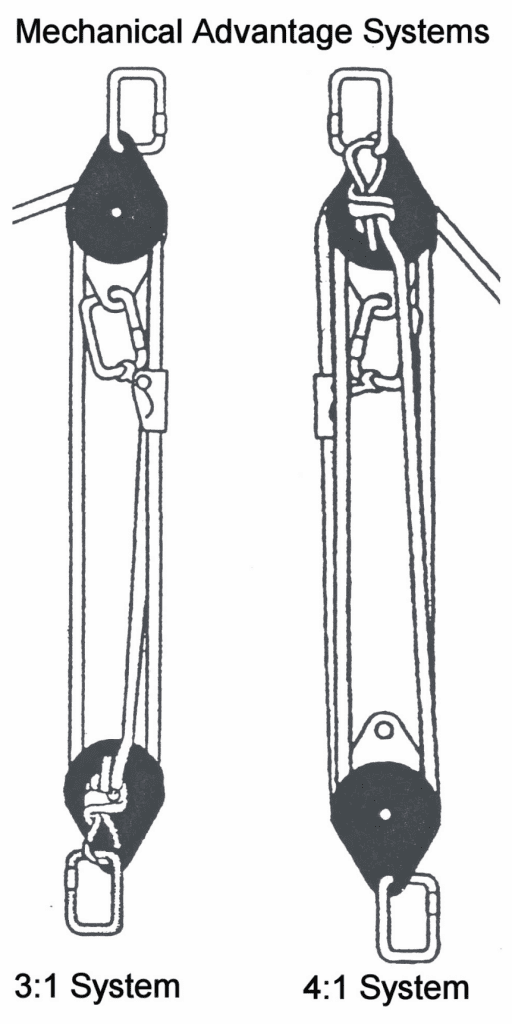
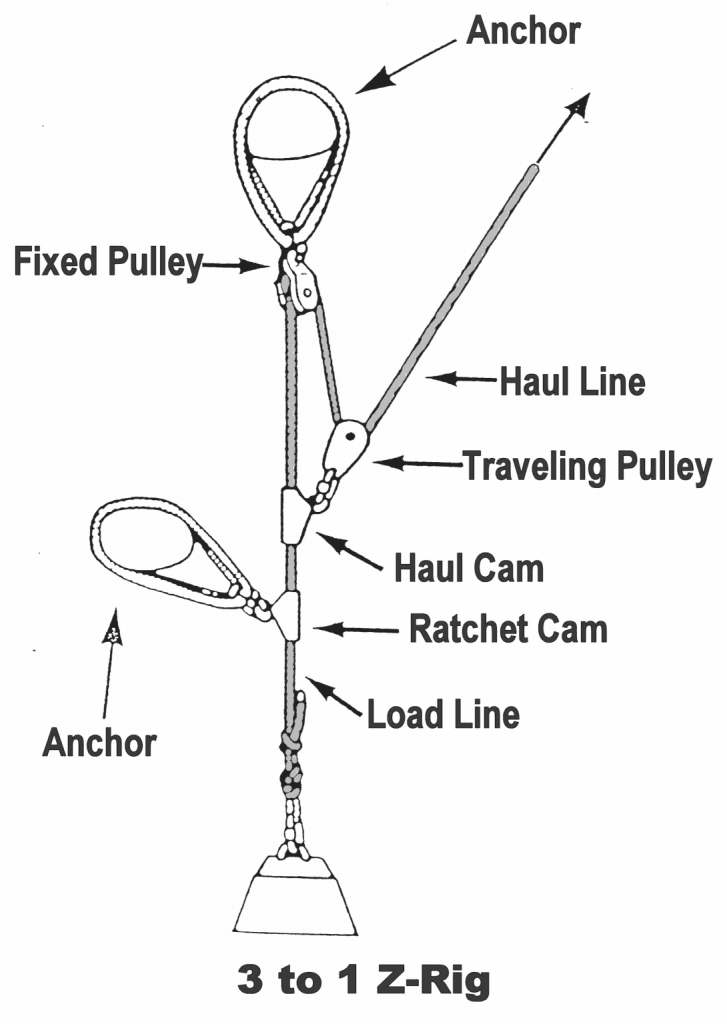
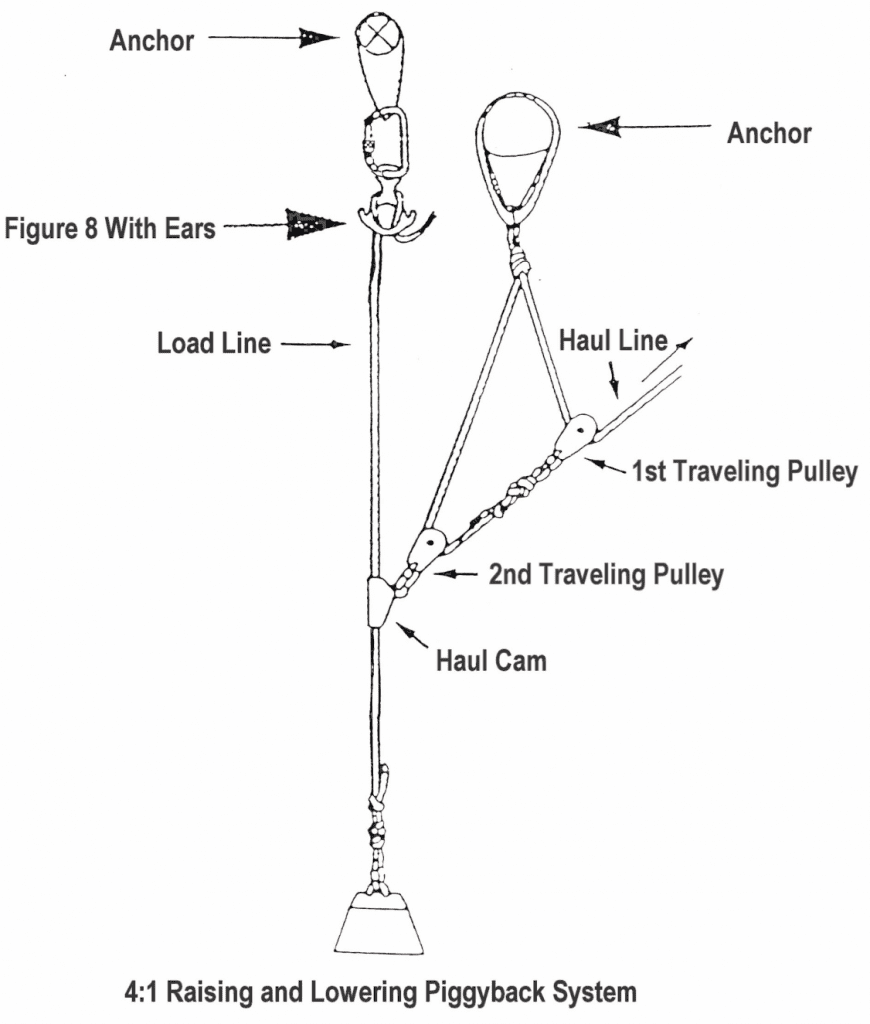
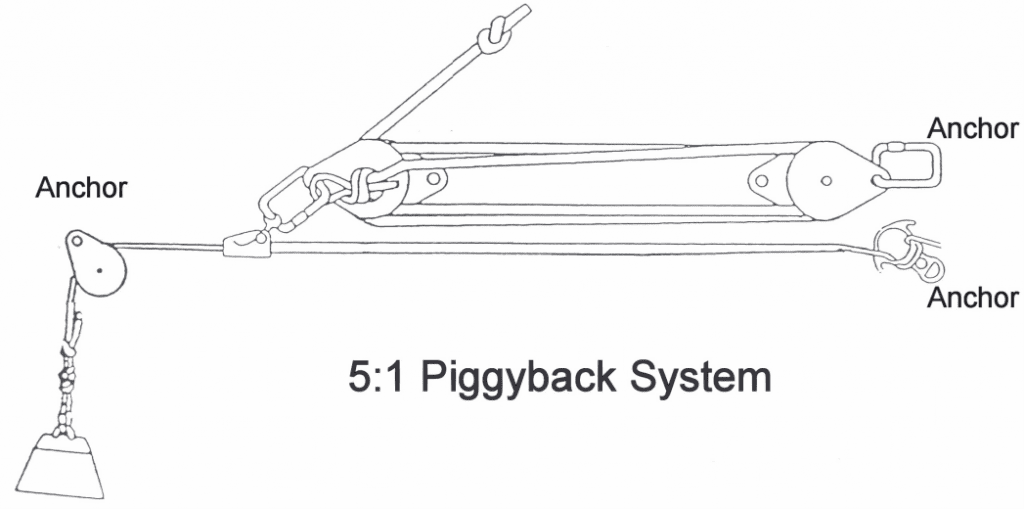
Team Members and Their Duties
A haul or lower team requires two to four people depending upon the mechanical advantage of the system. 4:1 systems require up to 4 people. Whereas 5:1, or greater, systems require only two people. Within this team someone needs to be designated for the following duties:
- Person-in-charge or Incident Commander
- Belayer and Safety Line
- Hole watch/Attendant
- Cam-person
- Rescuer
Individuals may be required to cover more than one duty, such as the Person-in- a charge may also need to be the attendant or on the haul team. This is dependent upon the number of personnel available and the type of rescue/rigging system used.
As in any efficient operation, communication is important. Knowing what each individual is doing and their responsibilities is vital. Raising and lowering operations have specific verbal terms used and are said by specific personnel. The following table provides examples of this terminology.
| TERM | WHO SAYS TERM | MEANING |
|---|---|---|
| On rope | Rescuer | Hooked-in the system. |
| On safety | Safety | A safety line is ready. |
| On belay | Attendant | Ready to raise or lower. |
| Lower/raise | Rescuer | Rescuer ready to go. |
| Lowering on | Attendant | The rescuer is lowered. |
| Down slow/fast | Attendant | Down slow or fast. |
| Haul slow/fast | Attendant | Raise slow or fast. |
| Set | Attendant | Stop raising and set cam. |
| Slack | Attendant | Prepare to reset the equipment and raise it again |
| Stop | Anyone | Stop the function because of an emergency or safety concern |
HAND SIGNALS
| SIGNAL | MEANING |
|---|---|
| Palm up / Thumb up | Raise |
| Palm down / Thumb down | Lower |
| Fist | Hold |
| Hand and arm moving back and forth horizontally | On the ground |
| Hand taps the top of the helmet | OK |
| Hand on throat OK | Emergency |
LINE SIGNALS
| SIGNAL | MEANING |
|---|---|
| 1 pull or tug | OK |
| 2 pulls or tugs | Advise |
| 3 pulls or tugs | Take-up |
| 4 pulls or tugs | Help |
Rescue Safety Rules
- Don’t proceed without proper PPE, equipment, personnel, and training.
- Make sure the confined space has been isolated.
- Use SCBA/SAR if not certain the atmosphere is safe.
- Do not use power equipment for human loads.
- The attendant never enters the space unless first relieved by another attendant.
- Have back-up rescue personnel available.
- Don’t risk a life for a body recovery. Weigh risk vs. benefit.
- Entry rescue team personnel requireme0n is about seven people.
(Read also:confined-space-safety-program-needs/)
Download the Infographic
Photo of the day: Confined Space rescue
More photos:
- What are the Best Practices for Managing Subcontractor Risk
- Photo of the day: 10 Essential Safety Tips for Driving in Hot Weather Conditions
- Photo of the day: best workplace safety tips
- Photo of the day: The Importance of Stop Work Authority in Maintaining Workplace Safety
- Photo of the day: Tomorrow’s Reward for Working Safely Today: Cultivating a Culture of Safety
- Photo of the day: Preventing slips and trips at work
- Photo of the day: Learn the DRSABCD action Plan
- Working with Electricity Electrical Accidents Guide for Electrical Workers
- Photo of the day: Hearing Protection Device Selection
- Photo of the day: If An Earthquake Shakes You-Infographic free
- Fire Safety Posters Free Download
- Photo of the day: First Aid for Electrical Burns-Infographic free
- Infographic: First Aid for Cuts and Scrapes free download
- Photo of The day: Work Safe with Lasers-Laser Safety free
- Photo of the day: Working Safely with chemicals and chemical Management
- Photo of the day: Safe work practices when using MEWPs ( updated)
- Photo of the day: Preventing Common Kitchen Hazards
- Photo of the day: Safe handling of Gas Cylinders and lecture bottles
- Photo of the day: Forklift Stability Triangle
- Photo of the day: Defective Tools Safe Work Practice
- Photo of the day: Lift With Your Legs Not With Your Back
- Photo of the day: First Aid for burns
- Photo of the day: The 7 Principles of HACCP
- Photo of the day: Working Safely with Suspended Loads
- Photo of the day: Heat Stroke First Aid and safety posters
- Photo of the day: Near-Miss Reporting and Posters
- Photo of the day: Ergonomic chair and office chair safety tips
- Photo of the day: Whole Body Vibration
- Photo of the day: Substation Safety Equipment
- Photo of the day: Bypassing Safety Controls Rules
- Photo of the day: Lightning Safety Tips
- Photo of the day: Overhead Power lines Clearance
- Photo of the day: Floor Marking
- Photo of the day: Types of Foot Protection
- Photo of the day: Types of Hand Protection
- Photo of the day: Lockout and Tagout Safety
- Photo of the day: Fall Protection Plans
- Photo of the day: Flood Safety Tips
- Photo of the day: Read All Labels Work safe
- Photo of the day: Run Project safely with Crane Hand Signals
- Photo of the day: Flagman and Traffic control
- Photo of the day: Managing Risks of Exposure to Solvents in the workplace
- Photo of the day: Scissor Lift Safety
- Photo of the day: HSE Bulletin Board
- Photo of the day: Arc-Fault Circuit Interrupters (AFCI)
- Photo of the day: Safe use of ladders and step ladders
- Photo of the day: Concrete Truck Driver Hand Signals
- Photo of the day: Extension Cord Safety Tips
- Photo of the day: Protect your Head
- Photo of the day: choosing the right Anchorage
- Photo of the day: Work-Related Asthma
- Photo of the day: Top FIVE Heavy Equipment Construction Site Safety Tips
- Photo of the day: sun safety in the workplace
- Photo of the day: Cannabis and Impairment in the Workplace
- Photo of the day: Position for safety and comfort-Safety Tips
- Photo of the day: Generator Safety
- Photo of the day: Controlling COVID-19 in the Workplace-Physical Barriers
- Photo of the day: Manual Material handling
- Photo of the day: Personal Protective Equipment last resort
- Photo of the day: WHMIS 2015 – Pictograms
- Photo of the day: Indoor Air Quality
- Photo of the day: Noise in the affected workplace
- Photo of the day: Fatigue at Work
- Photo of the day: Don’t be Driven to Distraction
- Photo of the day: working in heat and Humidex Rating
- How to use Plate Clamps Safely: Safety Moment#34
- Photo of the day: Sitting at work
- Photo of the day: 5 ways to reduce the risk of Slipping and Tripping
- Photo of the day: Preventing the spread of contagious illness
- Photo of the day: Incident Investigations
- Photo of the day: 10 Scaffold Safety Essentials
- Photo of the day: Effective Health and Safety Committees
- Photo of the day: New worker Orientation & Safety Orientation checklist
- Photo of the day: Workplace Inspection
- Photo of the day: musculoskeletal disorders
- Photo of the day: Emergency preparedness in the workplace
- Photo of the day: Mental health in the workplace
- Photo of the day: Trenching Safety Tips That Can Save a Life
- Photo of the day: Dangerous Goods Classes
- Photo of the day: Safety Equipment for Confined Spaces
- Photo of the day: Tips to reduce Heat stress in the workplace
- Photo of the day: hierarchy of controls
- Your steps to chemical safety
- H2S Gas and how to handle its Emergency
- Photo of the day: Importance of Mock drill and Fire Action Emergency Procedure
- Photo of the day: Choosing the Right Face Mask and the difference between a respirator and face mask
- Photo of the day: Confined space safety Precautions
- Breath Safely: The Proper Use of Respiratory Protection
- Photo of the day: Electric shock survival
- Photo of the day: Chemical Spill Emergency Response
- Photo of the day: Construction Site fire Safety
- Photo of the day: Confined Space rescue
- Photo of the day: Conveyors Safety Tips

